Abstract
During the last decade, the concept of urban resilience has been increasingly implemented in urban planning, with the main aim to design urban development strategies. Urban resilience is a multi-dimensional and dynamic concept. When applied to urban planning, it consists of studying cities as complex socio-economic systems. Municipalities are currently working to undertake appropriate actions to enrich the resilience of cities. Moreover, several difficulties concern the evaluation of the impacts over time of the strategies designed to enhance urban resilience. The present paper proposes an integrated approach based on the System Dynamics Model (SDM) and the Analytic Network Process (ANP). The objective of this research is to describe the method and to illustrate its application to the area called Basse di Stura, located in the city of Turin, Italy. The method is applied to evaluate the possible impacts of two different urban scenarios in terms of the change of urban resilience performance over time. The final result is represented by an index that describes urban resilience performance.
1. Introduction
Cities across the world are extremely exposed to different hazards and risks, both natural and man-made [1,2,3,4,5]. These risks include all of the dimensions of cities, from the environmental to the socio-economic, which are mainly related to social vulnerability [6]. Thus, the concept of resilience is recognized as a critical paradigm in the actual urban agenda to make cities able to face and react to these uncertainties [1,7,8,9,10]. When applied to the urban planning field, urban resilience does not correspond to the ability of the urban system to return to its previous state as defined by the general meaning of resilience [9]. Instead, it has to be interpreted as the capacity of the urban system to absorb, to adapt and to respond to changes [6,7,11,12]. However, only a few cities have undertaken actions and strategies to improve their resilience [8,13,14,15,16,17]. This condition is determined by the difficulties related to the definition of urban resilience and its measurement [18,19].
This concept has been analyzed from the point of view of several disciplines, giving rise to several definitions in the literature [20,21], such as in climate change [22] or risk reduction [23] studies. However, a literature review clearly shows that urban resilience is a multi-dimensional and dynamic phenomenon that characterizes cities as complex systems [7,12,20,24,25,26]. Starting from the assumption “if you can’t measure it, you can’t improve it” [11,27], urban resilience measurement has become a fundamental aspect concerning the definition of strategies to enhance urban resilience [28,29,30,31,32]. Several methods have been proposed in the literature, that are both qualitative and quantitative [8,18,19,33,34]. Moreover, existing methods are considered to be underdeveloped in terms of evaluating urban resilience within its multi-dimensionality, complexity and dynamic behavior over time [14,18,19]. The main problem recognized in the existing methods is the lack of mutual interdependences among the different dimensions of urban systems [14,18,19,33,35,36]. The challenge is to provide an assessment method that is able to foresee the resilience of urban system in the future, starting from the current state and according to development strategies [37,38,39].
In this paper, an integrated evaluation approach based on Analytical Network Processes (ANP) [40,41] and System Dynamics Model (SDM) [42,43,44] is illustrated, according to their methodological background and operative characteristics. The main objective of this paper is to explore the ability of this approach to analyze the relationships among factors that afflict urban resilience and its role in the evaluation of actions to enhance urban resilience [45,46].
For this purpose, this paper illustrates the application of the proposed approach to analyze and evaluate two different scenarios (Inertial and Strategic) developed for a downgraded area in the city of Turin (Northern Italy) [47,48,49], in terms of their possible impacts on urban resilience performance over time [50].
The paper is structured as follows: Section 2 illustrates the integrated approach; Section 3 is focused on the application of the proposed integrated approach to the real case study; Section 4 is related to the discussion of the results; and Section 5 concerns the conclusions and the final remarks related to future research perspectives.
2. Method
The proposed method is an integrated evaluation approach based on the combination of the System Dynamics Model (SDM) and the Analytic Network Process (ANP). In this section, these two techniques are illustrated, highlighting their methodological background and operative characteristics.
2.1. Analytic Network Process
2.1.1. Properties and State of the Art
The Analytic Network Process (ANP) is a special method of the wide set of multi-criteria analysis methods (MCA). ANP is often used to analyze complex issues related to the decision-making process, due to its power to deal with qualitative and quantitative attributes and to identify the relationships between decision elements [51,52,53]. It is recognized as a generalization of the Analytic Hierarchy Process (AHP) [54,55,56]. Generally, multi-criteria techniques are based on the principle of independency of the elements involved in the evaluation. In contrast, the peculiarity of the ANP is its capability to identify and to consider the mutual dependencies between the criteria of the evaluation process [57,58,59]. In detail, the interrelations that occur between the elements are defined as “feedbacks”. The basic structure of the ANP is represented by a network of clusters and nodes, i.e., the elements, that are contained in the clusters (Figure 1). The clusters represent both the criteria and the alternatives [53].
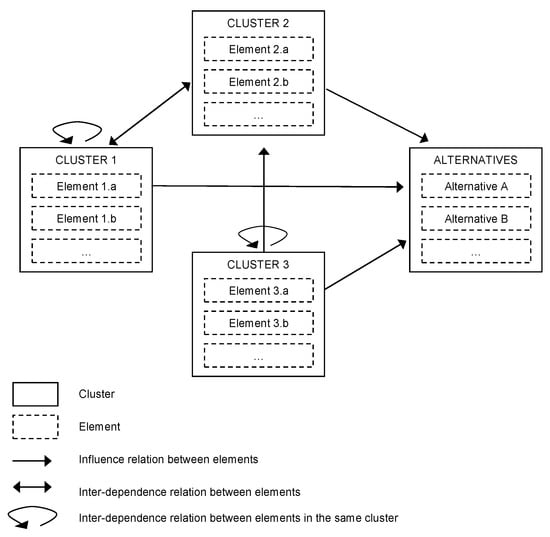
Figure 1.
Network structure example (Bottero et al., 2007).
The network structure of the ANP allows us to represent the decision problem within its complexity [54,55,56]. As a matter of fact, interdependence among different elements of the problem can occur, such as: alternatives, criteria, sub-criteria and goals. In detail, interconnections are represented by lines, connecting elements or nodes to each other. Figure 1 illustrates the general structure of an ANP network where: (1) feedback connect components to other elements and (2) loops connect a component to itself [40]. Furthermore, in the network it is possible to identify the source node, that is the origin of the path of influence, and to identify the sink node, that is the final destination of influence [54,55,56,60]. ANP is recognized as a suitable decision-support tool, able to face those decision problems characterized by high level of interactions and interdependences between the elements. It is employed to analyze those issues which cannot be structured hierarchically [51,52,53,57]. However, the literature on the implementation of an ANP in the assessment of urban transformation strategies is not vast [61]. Specifically, the literature about the integration of ANP with SDM is very limited [62]. Furthermore, the current literature about the application of ANP in resilience evaluation is mainly related to the risk and vulnerability assessment [63], focusing on risk management and risk reduction [64,65]. In this context, this paper illustrates one of the first applications of the integration of ANP with SDM to the urban resilience assessment field.
2.1.2. Methodology
The main steps of the ANP are summarized as follows:
1. Decision Problem Arrangement
The decision problem has to be included in the network structure (Figure 1). The first operation of this phase is to identify the evaluation goal. Once the goal has been defined, the second step is to recognize criteria (clusters/nodes) and alternatives. Furthermore, the relationships which occur among the elements must be identified during the development of the network. Different methods can be applied to obtain the network structure, such as focus groups and brainstorming [53].
2. Pairwise Comparison
In ANP, the pairwise comparison is applied to compare the elements and to establish their preferences [55,56,59]. Indeed, the different priorities are identified using the pairwise comparison and judgment both for clusters and nodes. Specifically, clusters are weighted by considering both their single role and impact and their mutual dependence among the clusters. The relative elements’ relevance is evaluated through the Saaty nine-point scale (Table 1). In this phase, the internal importance vector , that stands for the relative importance of elements or clusters, is calculated through (Equation (1)):
where A is the pairwise comparison matrix of the criteria, w is an eigenvector and λmax is the largest eigenvalue.

Table 1.
Saaty’s fundamental scale (Saaty, 1980).
3. Supermatrix formulation
The preferences obtained from the pairwise comparison are illustrated through the supermatrix (Figure 2). This matrix is defined as a block matrix in which the elements of each block are defined by the relationships between and within the levels, as represented in the network [53].
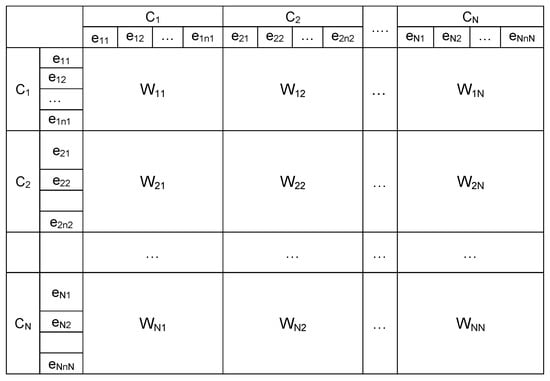
Figure 2.
Supermatrix general structure (Source: elaboration from Bottero et al., 2007).
Figure 2 illustrates the general structure of the supermatrix, in which Ci represents the ith cluster; for i = 1,…N, eij indicates the jth element within Ci, for j = 1,… , Wij is the block matrix that involves the priority weight vectors (w) of the influence of the elements in the ith cluster with respect to the jth cluster. If the ith cluster has no influence on the jth cluster itself (a case of inner dependence), then the elements of Wij are zero.
The supermatrix can support both the identification and the understanding of the relationships among the network. Furthermore, it provides the information about the priority of the elements that characterize the decision problem [54,55,56,59].
4. Selection of the preferable alternative
The final step of the ANP development are the calculation of the weighted supermatrix and final supermatrix. This matrix is processed to get a stable set of weights, that characterize the different elements [58]. The supermatrix is structured to get the global priority vector (Equation (2))
where Wk is the supermatrix.
2.2. System Dynamics Model
2.2.1. Properties and State of the Art
System Dynamics Models (SDMs) are both computer-aided and theoretical tools that are employed to analyze dynamic and complex systems, characterized by mutual feedbacks and interdependences [66]. SDMs are based on the approach of the System Dynamics (SD). SD was introduced by Forrester [42,43,44] at the end of the 1950s to improve the understanding of the strategic processes related to complex systems [67]. The theory of SD is a suitable tool to describe complex and dynamic systems through the identification of the mutual relationships that occur among variables [45,68]. Furthermore, this approach is employed to analyze the impacts of different factors on defined objectives, providing useful information for the decision-makers [69]. The theory of System Dynamics gives the fundamental guidelines to structure the model that describes the system through the employment of feedback loops, stocks and flows. The System Dynamics Model is grounded on feedback concepts to manage non-linearity, multi-loop and time-lag characteristics of complex dynamic systems. SDM can be considered as an efficient scenario simulation approach that is able to reveal the likely temporal behavior of complex systems [68]. Therefore, it can be also used to support the definition of policies for sustainable development [70,71]. As a matter of fact, an increasing amount of SDM applications have been recognized in the literature in the last few decades [72]. In detail, SDMs are nowadays applied for dynamic and complex systems that involve a high level of uncertainty. Important fields of application are: transportation [73], land use [74], environment management [75], waste management [76], project management [77] and sustainable urban development [46,72,78,79]. However, there are few existing studies that have applied SDMs to simulate and to evaluate urban resilience within its evolution over time [38,80]. Furthermore, despite the ability of SDM to deal with scenario assessment [78], its integration with MCA in urban development and urban resilience assessment fields is quite limited. For this reason, this paper aims to highlight the potentiality of SDM integrated with MCA [81] in the context of urban resilience measurement.
2.2.2. Methodology
The main steps to structure a SDM can be summarized as follow [67]:
- Identify the problem. This is the first step to implement the SDM. This phase concerns the identification of the problem, in order to set the boundaries of the system and define the specific objective;
- Develop a dynamic hypothesis. This step is referred to a theory that allows us to consider the mode behavior over time. In detail, the dynamic hypothesis is a conceptual model that consists of a causal loop diagram, stock and flow diagram or their combination;
- Create the basic structure of a causal graph. This phase concerns the processing of the causal loop diagram with the identification of the most important elements of the system and the relationships that occur among them;
- Augment the causal graph with more information. In this step, secondary and tertiary elements of the system are identified, in order to describe it in accurately;
- Convert the augmented causal graph to a system dynamics flow graph. This step refers to the translation of the causal loop diagram into the stock and flow diagram that is used to simulate the dynamic behavior of the system over time;
- Translate a system dynamics flow graph into programs or equations. This phase is fundamental to get the representation of the dynamic behavior of the system over time.
In detail, this section describes the phases of creating a basic structure of causal graph and a system dynamics flow graph. The basic structure of a causal graph is represented by the causal loop diagram (Figure 3) [78]. This diagram is used both to recognize the mutual influences which occur among the variables of the systems and to develop the feedback loops [45,69,74]. The processing of the causal loop diagram is the first phase to describe the dynamic behavior over time of the complex system [38,82]. Moreover, the mutual influences among variables can be either positive or negative [67]. A positive relationship means that the two variables will change in the same way. As an example, if variable A increases, then variable B will also increase. Within a negative relationship, the variables will change inversely. For instance, if variable C increases, variable B will decrease. Figure 3 illustrates a general structure of the causal loop diagram, identifying its main elements.
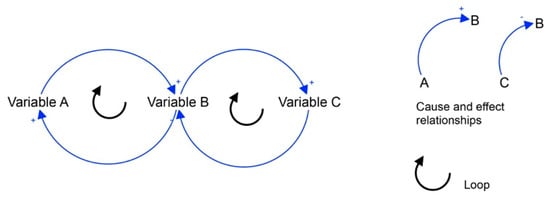
Figure 3.
Causal loop general structure.
The evolution dynamics of the system is represented by stocks and flows diagrams in Figure 4 [9,10,26]. Specifically, stocks stand for those variables that both describe and characterize the state of the system at any particular time [45,69,83,84]. The second elements of the SDM are flows. These elements illustrate how stocks can change over time [67]. Furthermore, flows can impact stocks via the inflow or outflow and also interconnect the stocks within a system [68]. The final element of SDM model are the conveyors that represent the external inputs to the model. In fact, they are also used to represent different actions for the policy simulation and analysis [46,67]. Figure 4 illustrates the basic elements of a stock and flow diagram.
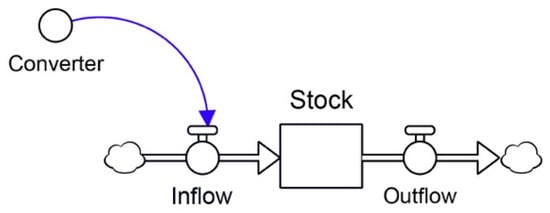
Figure 4.
Stock and Flow general structure.
Furthermore, the stock and flow diagram represents integral finite differential equations that consider the feedback loops. The dynamic behavior of the system is obtained through their integration [67]. In this sense, stock and flow diagram can support the examination of the possible effects over time of different strategies through the simulation model that is grounded on differential equations [38,72,78].
3. Case Study
3.1. Basse Di Stura Area
The approach illustrated above was applied to analyze the area of Basse di Stura, located in Turin (Northern Italy) (Figure 5). This area extends over 150 hectares and it is delimited by three main arterial roads and by the Stura river (Figure 6). The neighboring areas of Basse di Stura count 126,666 inhabitants. It is considered a critical part of the city of Turin due to its social and environmental conditions [85], meaning any serious threat would be a major concern for a large part of the city’s community [86,87].
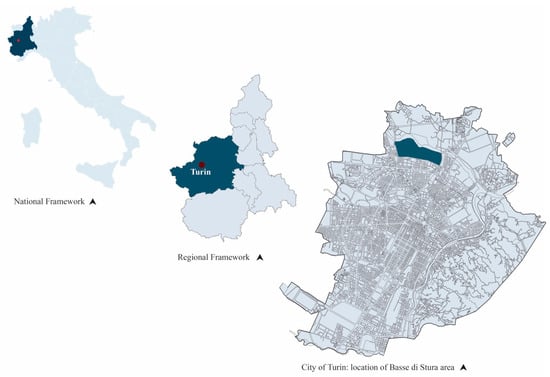
Figure 5.
Territorial framework and identification of the area of Basse di Stura.
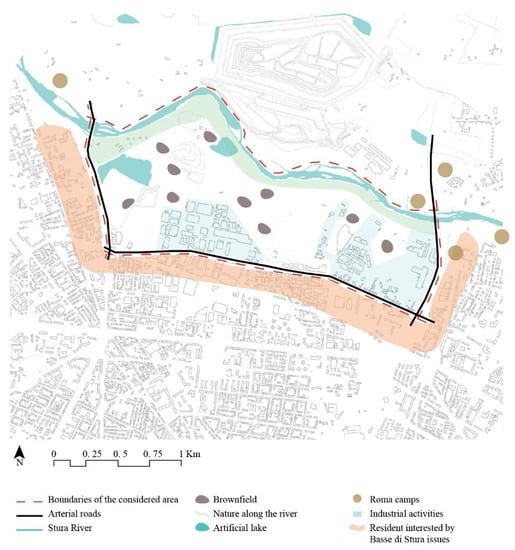
Figure 6.
Main characteristics of Basse di Stura area (re-elaboration from Bottero et al., 2019).
The main elements to be pointed out are:
- Industrial activities. A total of 40% of the entire area is covered by industrial buildings. Furthermore, most of them are actually abandoned and their bad state of conservation exposes them to several risks, such as collapse and fire;
- Brownfields. This is the main issue for the area of Basse di Stura. The high level of contamination (around 25% of the entire area) is due to the high presence of industrial activities in the past and the illegal disposal of industrial waste. For this reason, until 2013 this area has been classified as one of the contaminated sites of national interest by Italian Ministry of Environment and Sea [82];
- Roma camps. These represent the main social challenge for the Basse di Stura area (Figure 6). Several Roma camps are located in the Northern part of the Basse di Stura area. Most of these settlements are not regular and they create several health and hygienic issues [86].
The areas surrounding Basse di Stura are residential areas with a high population density [86]. In this context, the issues and the pressures that characterize this area can afflict a great portion of local community (Figure 6).
For these reasons, the public administration is actually interested in intervening to improve the general condition of this area [85]. Thus, this paper proposes the application of the integrated approach to simulate the possible effects and impacts of an Inertial and a Strategic scenario, in terms of changing of the urban resilience performance over time [50]. The area of Basse di Stura has been examined through a multi-dimensional and multi-perspective approach [49]. In detail, this choice has been made considering the peculiarity of the examined area and the effects that its conditions could have on different aspects of the city of Turin, especially in environmental and social dimensions (e.g., the health and safety of inhabitants). The final objective of this application is identifying which strategy could improve on the initial conditions over time, enhancing urban resilience.
3.2. Strategic Scenario
The strategic scenario describes the possible actions that could be undertaken to improve the current conditions of the Basse di Stura area [88]. These interventions have been defined through an in-depth analysis of the conditions of the area. The strategic scenario is based on the following actions:
- Retrieve the brownfield areas. The target is reclaiming some of the brownfield areas (Figure 7);
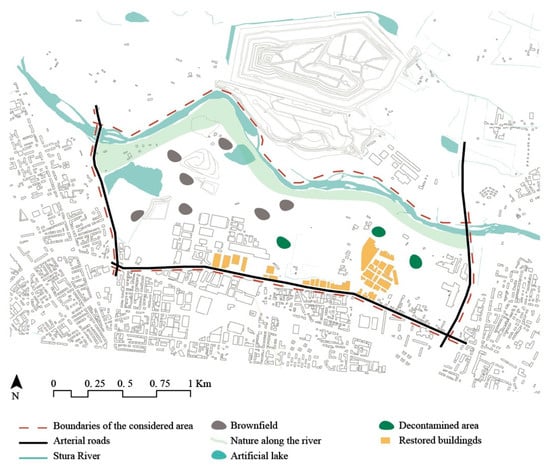 Figure 7. Strategic scenario intervention scheme.
Figure 7. Strategic scenario intervention scheme. - Restoring some of the abandoned existing buildings, to insert some new activities to improve both social and economic conditions (Figure 7);
- Reducing the soil consumption. The main aim is trying to maintain minimum extensions of the permeable surface. This objective is mainly due to the proximity of this area to the Stura river, while also considering its environmental potentiality;
- Enhancing better conditions for the socio-economic dimension, through the hypothesis of creating new businesses in the restored buildings.
4. Application
As mentioned in the previous section, the integrated approach has been applied to analyze and evaluate the possible effects of two different scenarios on the area of Basse di Stura, according to the changing of the urban resilience performance. The specific application is detailed and described in the following sections.
4.1. Structuring of the Model
The proposed integrated approach has been performed through a multi-steps structure. Figure 8a shows the general framework and Figure 8b illustrates how the general framework has been applied and adapted for the specific case study.
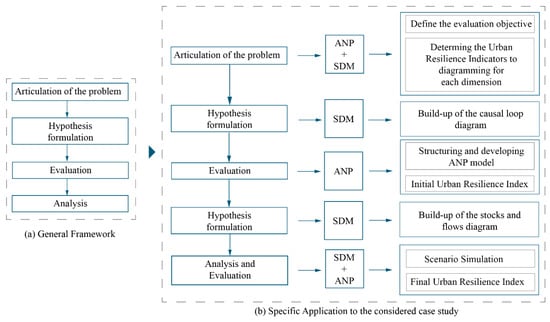
Figure 8.
Structuring of the evaluation model.
The first phase consists in the definition of the evaluation objective and the urban resilience indicators. The combination of the ANP and SDM helps the identification of the components. The second phase consists of the development of the causal loop diagram (Figure 9) in which the relationships among indicators have been identified. The third phase refers to the design of the ANP model and to the evaluation of the urban resilience index, and also refers to the current state of the area of Basse di Stura (Appendix A). In the fourth phase, the causal loop diagram is transposed into the stock and flow diagram. The final phase concerns the scenario simulation and the evaluation of the urban resilience performance, using the results obtained through the SDM simulation.
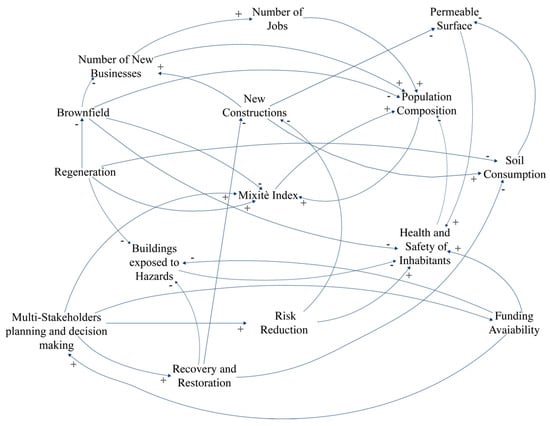
Figure 9.
Causal loop diagram for Basse di Stura area (Datola et al., 2019).
4.2. Identification of Indicators
After the goal of the evaluation is defined (Figure 8), the subsequent step foresees the identification of the indicators related to urban resilience concept to structure the SDM.
In line with the literature of urban resilience indicators [6,89,90], in this paper we consider the indicators that refer to the following five dimensions: (1) economy, (2) society, (3) built environment, (4) environment (5) governance. To better identify specific and accurate indicators for the area of Basse di Stura, experts followed the questions proposed by Meerow [20] as conceptual guidelines. Table 2 lists the set of 15 multidimensional indicators specifically fitted for this case study of Basse di Stura.

Table 2.
Urban Resilience variables for the SDM (Datola et al., 2019).
4.3. Causal Loop Diagram
Once the indicators have been identified, the subsequent step consists of the implementation of the SDM. The first phase is to build up the causal loop diagram (Figure 9). The causal loop diagram (Figure 9) has been processed during an expert focus group, in which the basis of the cognitive mapping was recalled [82,91]. In fact, experts were asked to identify the mutual relationships among the considered indicators (Table 2), while also considering their mutual influence [46]. In detail, this diagram has been built both on the literature review on urban dynamics [78,92,93] and on the experts’ knowledge. Figure 9 illustrates the causal loop referred to the Basse di Stura area, in which the relationships among social, economic, environmental and governance indicators have been identified. As an example, the variable “Soil Consumption” has a negative influence on “Permeable Surface”.
4.4. Structuring the ANP Model
In this application, ANP has been selected for its ability to consider the dependences between the evaluation criteria. Moreover, the considered indicators (Table 2) have been organized in cluster and nodes, as suggested by the literature.
Figure 10 illustrates the ANP network developed for the case study of Basse di Stura. In detail, the network is not only a final result of experts’ brainstorming, but it is also built up on a causal loop diagram (Figure 9). In fact, all the relationships recognized in the causal loop have been also inserted in the ANP network. Thus, it is possible to observe the influence between indicators and clusters, indicators and goals and also feedback on the same elements. As an example, the ANP network shows the feedback of the “Environment” cluster, that is determined by the influences of its nodes as determined in the causal loop diagram.
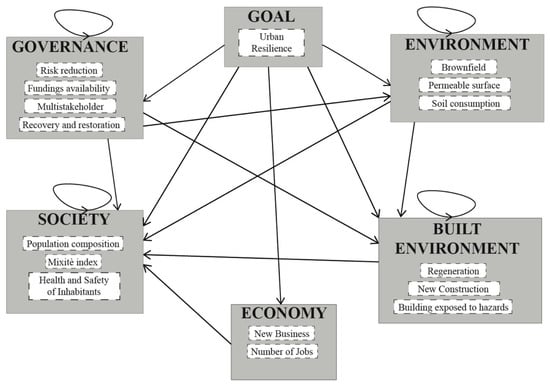
Figure 10.
ANP network for the Basse di Stura Area outlined through the SUPERDECISION software.
4.5. Determination of the Weights of Indicators
As mentioned in Section 2, ANP requires the pairwise comparison to establish the priorities between indicators involved in the evaluation. Experts were asked to assess the relevance of the considered indicators in accordance with the Saaty’s fundamental scale (Table 1). The first step of the evaluation concerns the pairwise comparisons among the clusters. Thus, the matrixes with the assessment performed through the pairwise comparison have been developed. These matrixes show the numerical values that represent the influence identified for the elements of the network. Once we established the priorities of the clusters, the subsequent step was performing the pairwise comparison for the nodes. As for the examination of the clusters, the judgments have been made in accordance with the influences and interdependencies recognized in the network. Both the comparison of the clusters and nodes have been obtained through discussion with a multidisciplinary panel of urban planning and assessment experts. As an example, Table 3 and Table 4 illustrate the pairwise comparison for clusters and nodes. Table 3 shows the pairwise comparison between “Built Environment” and “Environment”. In detail, the assigned value “3” refers to the fundamental Saaty’s scale (Table 1). This means that experts considered the dimension of the environment as being much more important than the built environment.

Table 3.
Pairwise comparison between Built Environment and Environment Cluster.

Table 4.
Pairwise comparison between Environment nodes.
Table 4 shows the pairwise comparison between the nodes belonging to the environmental cluster. As for the previous pairwise comparison, the value assigned are used with Saaty’s fundamental scale to determine the relevance of the different indicators. In detail, the assigned values mean that (1) the soil consumption is more important than the permeable surface (value 3); (2) the brownfield is very much important than the permeable surface (value 7); and (3) the brownfield is much more important than soil consumption (value 5). A great importance has been given to the brownfield. This is because the Basse di Stura area is a brownfield area. In this context, it is possible to underline that the pairwise comparison has been made considering the specific condition of the examined decision problem.
4.5.1. Supermatrix Formulation and Final Priorities
Once all the pairwise comparison matrixes for both the clusters and nodes are obtained, the totality of these related priorities develops the unweighted supermatrix (Appendix B). The supermatrix represents the relationships among the nodes that compose the network. Moreover, the unweighted supermatrix has been multiplied for the final vector priorities (Table 5) to get the weighted supermatrix (Appendix C).

Table 5.
Final vector priorities.
Table 5 illustrates the final vector priorities obtained through the evaluations. These priorities give a great importance to (1) the brownfield, (2) health and safety of inhabitants, (3) permeable surface and (4) regeneration, while little importance has been given to the economic aspect. These priorities can be considered as the result of the combination of two different reasoning, that are (1) causal-loop diagram development and (2) pairwise comparison. It is important to underline that through the processing of the causal loop diagram, it was possible both to understand the mutual interdependences between the considered criteria and their possible effects on the Basse di Stura Area. As an example, the second most important criteria is the “health and safety of inhabitants”, which is also strictly related to the extension of the brownfield area.
4.5.2. Current Urban Resilience Index
As underlined in the previous sections, the objective of this application is evaluating the inertial and the strategic scenario in order to assess their evolution over time, in terms of urban resilience performance. To pursue this objective, it is necessary to analyze the current urban resilience performance of the area. For this reason, the current urban resilience index has been calculated. This index has been obtained through the Equation (3):
where:
Si = Σeij × wj
- Si stands for the final score;
- eij represents the normalized value of each indicator;
- wi represents the weight of each criterion
The Equation (3) allows to combine the current performance of the area (Appendix A) for each indicator with the corresponding weights, obtained through the ANP (Table 5).
To obtain the current urban resilience index through the Equation (3), the performance of each indicator has been firstly normalized through the Equations (4) and (5):
Normalization allows us to make all the indicators comparable in an interval between 0 and 1. In detail, Equation (4) is applied to normalize those indicators that have positive impacts on the considered objective. In addition, Equation (5) is used to normalize those indicators with negative impacts on the evaluation objective. The index obtained for the current urban resilience performance for Basse di Stura is 0.07. This low performance is based on the bad performance of the Basse di Stura area in (1) Brownfield, (2) Health and Safety of Inhabitants and (3) Buildings exposed to hazards, which are all considered as important in this context (Table 5).
4.6. Stock and Flow Diagram
The causal loop diagram has been applied as the basis to develop the stock and flow diagram. As shown in Figure 11, some indicators have been characterized as stocks and others as flows [78]. Strategy inputs have been converted into the conveyors, because these elements are used to describe the external conditions the actions/policies in the model [67].
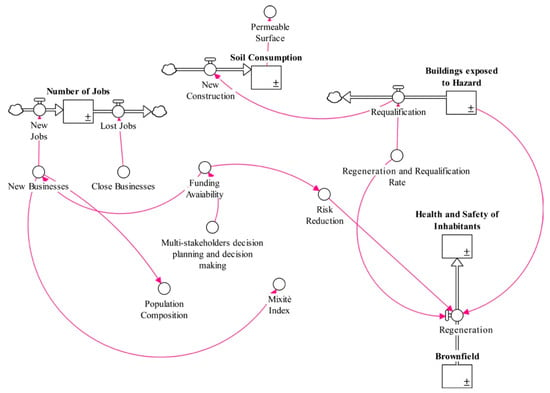
Figure 11.
Stock and Flow diagram for the Basse di Stura area (Datola et al., 2019).
The variables described as stocks are: (1) Brownfield, (2) Soil consumption, (3) Health and Safety of the Inhabitants, (4) Buildings exposed to hazards and (5) Number of Jobs. In detail, the stocks are those variables that characterize the evolution of the system. In this context, these variables have been translated into stocks in order to assess how they can characterize the Basse di Stura area over time.
To obtain the SDM simulation (Figure 12, Figure 13 and Figure 14), different balance equations have been developed. These formulas can be generally described as follow Equation (6):
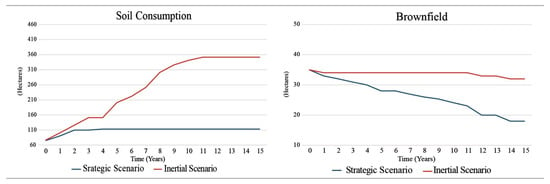
Figure 12.
Simulation of the evolution of environmental variables over time (Datola et al., 2019).
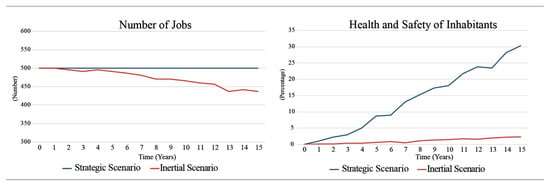
Figure 13.
Simulation of the evolution of economic variables over time (Datola et al., 2019).
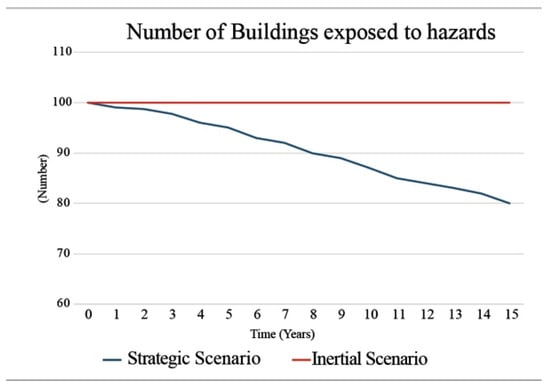
Figure 14.
Simulation of the evolution of the number of building exposed to hazards over time (Datola et al., 2019).
As an example, the equation of the variable of soil consumption can be expressed as:
Soil Consumption(t) = soil consumption (t − dt) + (new construction)*dt.
In this sense, the changing over time of the soil consumption simulation is the result of the combination of the current soil consumption at the year 0 (Figure 12) plus the new construction. Furthermore, other specific equations have been developed to implement the SDM to simulate both the possible impacts and influence in enhancing urban resilience over time of the two scenarios considered (Strategic and Inertial) [50].
5. Results
SDM scenario analysis is useful to provide a possible range of futures, based on policies and actions [78]. In SDM, the values of variables and parameters can be adjusted to describe different actions and scenarios. The results of the simulations will be different based on the different inputs [78]. As previously mentioned, this paper considers two different scenarios: the inertial scenario and the strategic scenario [50]. The inertial scenario stands for no actions policy, while the strategic scenario represents the possible action to undertake for the improvement of the condition of the Bassa di Stura area. To characterize these two scenarios in the SDM model [45,78], different values have been established for the parameters: (1) recovery and restoration; (2) risk reduction; and (3) multi-stakeholder decision planning. In detail, low values have been established for the inertial scenario, to represent the no intervention policy. Also, medium values have been established for these parameters to represents the actions (Section 3.2) of the strategic scenario in the SDM model. Scenarios simulations have been performed for 15 years through SDM (STELLA®, ISEE Systems Inc.), starting from the stock and flow diagram (Figure 11). Specifically, these simulations have been developed for the variables identified as stocks. The main objective is testing their probable effects over time and how they could affect the urban resilience performance of the Basse di Stura area over time [50]. Figure 12, Figure 13 and Figure 14 illustrate the simulations, through which it is possible to highlight the differences in the evolution over time of these considered scenarios.
6. Discussion
We have shown how the inertial scenario and the strategic scenario have significant differences in the performances of “soil consumption” and “brownfields” (Figure 12), “health and safety of inhabitants” (Figure 13) and “number of buildings exposed to hazards” (Figure 14).
In detail, the strategic scenario shows a more limited increase in soil consumption than the inertial scenario. This behavior is due to the different values assigned to the “regeneration and requalification rate” parameter. In fact, this parameter has a decreasing impact on “new construction” variable, as highlighted on the causal loop diagram (Figure 9). Moreover, the parameter of regeneration also has a decreasing impact on the “brownfields” and the “number of buildings exposed to hazards”. In fact, the strategic scenario also shows decreasing tendencies over time in these variables. Moreover, the improvement of these conditions also implies a positive evolution in the social variable of the “health and safety of the inhabitants” (Figure 13), as identified in the causal loop diagram (Figure 9). However, no considerable differences have been recognized for the economic variable “number of jobs”. These specific results can be explained through two different aspects. Firstly, the actions of the strategic scenarios are mainly focused on intervening on the environment and built environment dimensions. Secondly, the general tendencies of the economic sector of the city have also been to determine the possible tendencies of the number of jobs at this scale of analysis.
This analysis has been useful to highlight that the improvement of (1) Brownfield, (2) Buildings exposed to risks and (3) Soil consumption can decrease the pressures that the conditions of the area of Basse di Stura can afflict on the city as a whole, especially in social terms (the Health and Safety of the Inhabitants). Furthermore, it also underlines that for the improvement of the economic conditions of this area, more integrated actions and policies are required.
Moreover, to analyze in depth the possible impacts of the considered scenarios in terms of changing urban resilience performance over time, final indexes referring to time 15 (t15) have been calculated for both scenarios. These indexes are calculated using Equation (3) that combines the normalized performance at time 15 of these scenarios obtained by the relevant simulations (Appendix C) with the weights of each criterion, which is obtained through the ANP (Table 5). Figure 15 illustrates and compares the obtained indexes. The final urban resilience index for the strategic scenario is 0.85. At the same time, the index obtained by the inertial scenario is 0.10. These indexes underline that the strategic scenario could improve the resilience performance of the area over time, including through a reduction of the soil consumption, the decontamination of brownfields, an improvement of the level of the safety of inhabitants and the adaptation of many buildings exposed to risks.
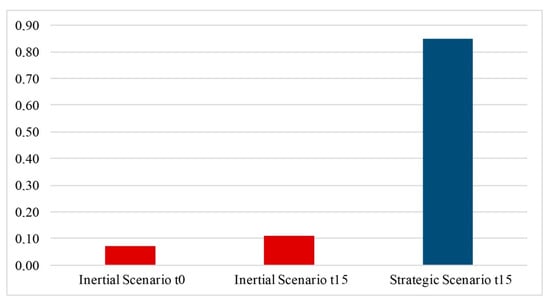
Figure 15.
Urban Resilience Index.
7. Conclusions
This paper illustrates the application of an integrated approach based on the combination of SDM and ANP to simulate the effects on urban resilience performance over time of two different scenarios. The main challenge of this application was trying to provide an evaluation tool that is able to assess urban resilience within its complexity, multidimensionality and dynamic behavior over time [18,37] in response to the current lack of an urban resilience measurement tool [94]. The choice of combining these two techniques arises from their common aspects, which can be summarized as follow:
- (1)
- They both examine the nature of the decision problems under analysis. Both SDM and ANP are applied to describe (SDM) and analyze (ANP) complex and dynamic decision problems in many different fields, such as urban transformation.
- (2)
- They both assess the typology of mutual relationships. In real-world decision making, some problems have to be investigated considering the non-linear and feedback relationships between the variables involved. Both SDM and ANP are used based on this principle and for this reason they have been integrated to create a unique framework to analyze complex decision processes;
- (3)
- They both assess data in similar ways. Both SDM and ANP consider both qualitative and quantitative data.
This paper allows us to underline both the strengths and the weaknesses of the proposed integrated approach. The main strengths can be summarized as follow:
- The causal loop diagram can be considered as a suitable supporting tool in finding the relationships between the criteria to include in the ANP network. Experts were able to determine how the system functioned during the causal loop development (Figure 9).
- The integrated approach based on the combination of SDM and ANP can be considered suitable to respond to the need of an evaluation tool that is able to consider urban resilience based on its complexity, multidimensionality and dynamical behavior over time. In fact, it was possible to analyze the urban system as a complex and adaptive system, in which interventions on a specific urban area can elicit impacts (either positive or negative) on a city in a wide perspective.
However, the main limitation of the proposed approach is the lack of the spatial scale both in the simulation and evaluation of the impacts of the strategies. Thus, an interesting future implementation approach involves the integration of this combined approach with GIS, to also assess the effects of urban development strategies in the spatial scale [45,95]. The final aim is providing an integrated tool able to show both the evolution of the impacts of strategies in a unique map and to support decision-makers in defining strategies based on their effects both on a spatial and a temporal scale.
Author Contributions
All authors equally contributed to the article. All authors have read and agreed to the published version of the manuscript.
Funding
This research was funded by Department of Regional Studies and Planning, DIST—Politecnico di Torin, within the research project VALIUM, grant number 60_RDI19BOM01.
Acknowledgments
This paper is the extended version of the work Datola G., Bottero M., De Angelis E. (2019) How Urban Resilience Can Change Cities: A System Dynamics Model Approach. In: Misra S. et al. (eds) Computational Science and Its Applications—ICCSA 2019. ICCSA 2019. Lecture Notes in Computer Science, vol 11622. Springer, Cham, that was presented at the 19th International Conference on Computational Science and its Applications. Part of the work illustrated in the present paper was developed in the research project titled VALIUM (Valuation for Integrated Urban Management) that has been supported by the Department of Regional and Urban Studies and Planning—DIST of the Politecnico di Torino (II call 2019).
Conflicts of Interest
The authors declare no conflict of interest. The funders had no role in the design of the study; in the collection, analyses, or interpretation of data; in the writing of the manuscript, or in the decision to publish the results.
Appendix A

Table A1.
Performance matrix for Inertial Scenario and Strategic Scenario, at time t0 and t15.
Table A1.
Performance matrix for Inertial Scenario and Strategic Scenario, at time t0 and t15.
| Dimension | Criterion | Unit | Inertial Scenario (t0) | Strategic Scenario (t0) | Inertial Scenario (t15) | Strategic Scenario (t15) |
|---|---|---|---|---|---|---|
| Environment | Soil Consumption | Hectares | 65 | 65 | 350 | 110 |
| Permeable Surface | Hectares | 75 | 75 | 0 | 340 | |
| Brownfield | Hectares | 35 | 35 | 33 | 18 | |
| Society | Population composition | % | 0 | 0 | 0 | 0 |
| Mixitè index | [0–1] | 0 | 0 | 0 | 0.20 | |
| Health and safety of inhabitants | % | 0 | 0 | 3% | 30% | |
| Economy | New Business | Num. | 10 | 10 | 0 | 25 |
| Number of jobs | Num. | 500 | 500 | 440 | 500 | |
| Built environment | Regeneration | Hectares | 10 | 10 | 10 | 500 |
| New Construction | Hectares | 55 | 55 | 68 | 30 | |
| Number of Building exposed to hazards | Num. | 100 | 100 | 100 | 80 | |
| Governance | Risk reduction | 0–1 | 0 | 0.03 | 0 | 1 |
| Funding availability | 0–1 | 0 | 1 | 0 | 1 | |
| Multi-stakeholders decision planning and decision making | 0–1 | 0 | 0.03 | 0 | 0.03 | |
| Recovery and requalification | 0–1 | 0 | 0.3 | 0 | 0.3 |
Appendix B

Table A2.
Unweighted Super Matrix.
Table A2.
Unweighted Super Matrix.
| Built Environment | Economy | Environment | Governance | Society | ||||||||||||
|---|---|---|---|---|---|---|---|---|---|---|---|---|---|---|---|---|
| Building Exposed to Hazards | New Construction | Regeneration | New Business | Number of Jobs | Brownfield | Permeable Surface | Soil Consumption | Funding Availability | Multistakeholders | Recovery and Restoration | Risk Reduction | Health and Safety | Mixitè Index | Pop. Composition | ||
| Built Environment | Building exposed to hazards | 0.000 | 0.000 | 1.000 | 0.000 | 0.000 | 0.000 | 0.000 | 0.000 | 0.000 | 0.000 | 0.2500 | 0.2500 | 0.000 | 0.000 | 0.000 |
| New Construction | 0.000 | 0.000 | 0.000 | 0.000 | 0.000 | 0.000 | 0.000 | 0.000 | 0.000 | 0.000 | 0.000 | 0.000 | 0.000 | 1.000 | 0.000 | |
| Regeneration | 0.000 | 0.000 | 0.000 | 0.000 | 0.000 | 0.000 | 0.000 | 0.000 | 0.000 | 0.000 | 0.7500 | 0.7500 | 0.000 | 0.000 | 0.000 | |
| Economy | New Business | 0.000 | 1.000 | 0.000 | 0.000 | 0.000 | 1.000 | 0.000 | 0.000 | 0.000 | 0.000 | 0.000 | 0.000 | 0.000 | 0.000 | 0.000 |
| Number of jobs | 0.000 | 0.000 | 0.000 | 1.000 | 0.000 | 0.000 | 0.000 | 0.000 | 0.000 | 0.000 | 0.000 | 0.000 | 0.000 | 0.000 | 0.000 | |
| Environment | Brownfield | 0.000 | 0.000 | 0.9000 | 0.000 | 0.000 | 0.000 | 0.000 | 0.000 | 0.000 | 0.000 | 1.000 | 1.000 | 0.000 | 0.000 | 0.000 |
| Permeable Surface | 0.000 | 0.85714 | 0.000 | 0.000 | 0.000 | 0.000 | 0.000 | 1.000 | 0.000 | 0.000 | 0.000 | 0.000 | 0.000 | 0.000 | 0.000 | |
| Soil Consumption | 0.000 | 0.14285 | 0.10000 | 0.000 | 0.000 | 0.000 | 0.000 | 0.000 | 0.000 | 0.000 | 0.000 | 0.000 | 0.000 | 0.000 | 0.000 | |
| Governance | Funding availability | 0.000 | 0.000 | 0.000 | 0.000 | 0.000 | 0.000 | 0.000 | 0.000 | 0.000 | 0.000 | 0.000 | 0.000 | 0.000 | 0.000 | 0.000 |
| Multistakeholders | 0.000 | 0.000 | 0.000 | 0.000 | 0.000 | 0.000 | 0.000 | 0.000 | 1.000 | 0.000 | 0.000 | 0.000 | 0.000 | 0.000 | 0.000 | |
| Recovery and restoration | 0.000 | 0.000 | 0.000 | 0.000 | 0.000 | 0.000 | 0.000 | 0.000 | 0.000 | 0.500 | 0.000 | 0.000 | 0.000 | 0.000 | 0.000 | |
| Risk Reduction | 0.000 | 0.000 | 0.000 | 0.000 | 0.000 | 0.000 | 0.000 | 0.000 | 0.000 | 0.500 | 0.000 | 0.000 | 0.000 | 0.000 | 0.000 | |
| Society | Health and safety | 1.0000 | 0.000 | 0.000 | 0.000 | 0.000 | 0.8571 | 1.0000 | 0.000 | 0.000 | 0.8571 | 1.000 | 1.000 | 0.000 | 0.000 | 0.000 |
| Mixitè index | 0.000 | 0.000 | 1.0000 | 0.000 | 0.000 | 0.1428 | 0.000 | 0.000 | 0.000 | 0.1428 | 0.000 | 0.000 | 0.000 | 0.000 | 0.000 | |
| Pop. Composition | 0.000 | 0.000 | 0.000 | 1.0000 | 1.0000 | 0.000 | 0.000 | 0.000 | 0.000 | 0.000 | 0.000 | 0.000 | 1.000 | 0.000 | 0.000 | |
Appendix C

Table A3.
Weighted Super Matrix.
Table A3.
Weighted Super Matrix.
| Built Environment | Economy | Environment | Governance | Society | ||||||||||||
|---|---|---|---|---|---|---|---|---|---|---|---|---|---|---|---|---|
| Building Exposed to Hazards | New Construction | Regeneration | New Business | Number of Jobs | Brownfield | Permeable Surface | Soil Consumption | Funding Availability | Multistakeholders | Recovery and Restoration | Risk Reduction | Health and Safety | Mixitè Index | Pop. Composition | ||
| Built Environment | Building exposed to hazards | 0.000 | 0.000 | 0.22269 | 0.000 | 0.000 | 0.000 | 0.000 | 0.000 | 0.000 | 0.000 | 0.049695 | 0.049695 | 0.000 | 0.000 | 0.000 |
| New Construction | 0.000 | 0.000 | 0.000 | 0.000 | 0.000 | 0.000 | 0.000 | 0.000 | 0.000 | 0.000 | 0.000 | 0.000 | 0.000 | 1.000 | 0.000 | |
| Regeneration | 0.000 | 0.000 | 0.000 | 0.000 | 0.000 | 0.000 | 0.000 | 0.000 | 0.000 | 0.000 | 0.149084 | 0.149084 | 0.000 | 0.000 | 0.000 | |
| Economy | New Business | 0.000 | 0.11386 | 0.000 | 0.000 | 0.000 | 0.5000 | 0.000 | 0.000 | 0.000 | 0.000 | 0.000 | 0.000 | 0.000 | 0.000 | 0.000 |
| Number of jobs | 0.000 | 0.000 | 0.000 | 0.5000 | 0.000 | 0.000 | 0.000 | 0.000 | 0.000 | 0.000 | 0.000 | 0.000 | 0.000 | 0.000 | 0.000 | |
| Environment | Brownfield | 0.000 | 0.000 | 0.6061 | 0.000 | 0.000 | 0.000 | 0.000 | 0.000 | 0.000 | 0.000 | 0.68252 | 0.68252 | 0.000 | 0.000 | 0.000 |
| Permeable Surface | 0.000 | 0.75954 | 0.000 | 0.000 | 0.000 | 0.000 | 0.000 | 1.000 | 0.000 | 0.000 | 0.000 | 0.000 | 0.000 | 0.000 | 0.000 | |
| Soil Consumption | 0.000 | 0.12659 | 0.06734 | 0.000 | 0.000 | 0.000 | 0.000 | 0.000 | 0.000 | 0.000 | 0.000 | 0.000 | 0.000 | 0.000 | 0.000 | |
| Governance | Funding availability | 0.000 | 0.000 | 0.000 | 0.000 | 0.000 | 0.000 | 0.000 | 0.000 | 0.000 | 0.000 | 0.000 | 0.000 | 0.000 | 0.000 | 0.000 |
| Multistakeholders | 0.000 | 0.000 | 0.000 | 0.000 | 0.000 | 0.000 | 0.000 | 0.000 | 1.000 | 0.000 | 0.000 | 0.000 | 0.000 | 0.000 | 0.000 | |
| Recovery and restoration | 0.000 | 0.000 | 0.000 | 0.000 | 0.000 | 0.000 | 0.000 | 0.000 | 0.000 | 0.27248 | 0.000 | 0.000 | 0.000 | 0.000 | 0.000 | |
| Risk Reduction | 0.000 | 0.000 | 0.000 | 0.000 | 0.000 | 0.000 | 0.000 | 0.000 | 0.000 | 0.27248 | 0.000 | 0.000 | 0.000 | 0.000 | 0.000 | |
| Society | Health and safety | 1.0000 | 0.000 | 0.000 | 0.000 | 0.000 | 0.4285 | 1.0000 | 1.000 | 0.000 | 0.39002 | 0.11870 | 1.000 | 0.000 | 0.000 | 0.000 |
| Mixitè index | 0.000 | 0.000 | 0.10384 | 0.000 | 0.000 | 0.1428 | 0.071429 | 0.000 | 0.000 | 0.06500 | 0.000 | 0.000 | 0.000 | 0.000 | 0.000 | |
| Pop. Composition | 0.000 | 0.000 | 0.000 | 0.5000 | 1.0000 | 0.000 | 0.000 | 0.000 | 0.000 | 0.000 | 0.000 | 0.000 | 1.000 | 0.000 | 0.000 | |
References
- UN Office for Disaster Risk Reduction. How to Make Cities More Resilient; UNISDR: Geneva, Switzerland, 2012. [Google Scholar]
- World Economic Forum. The Global Risks Report 2018, 13th ed.; World Economic Forum: Geneva, Switzerland, 2013; ISBN 978-1-944835-15-6. [Google Scholar]
- UNISDR Hyogo Framework for Action 2005–2015. In Proceedings of the United Nations International Strategy for Disaster Reduc, Sendai, Japan, 14–18 March 2015.
- Grimm, N.; Faeth, S.; Golubiewski, N.; Redman, C.; Wu, J.; Bai, X.; Briggs, J. Global Change and the Ecology of Cities. Science 2008, 319, 756–760. [Google Scholar] [CrossRef] [PubMed]
- UNISDR (United Nations Office for Disaster Risk Reduction). Sendai Framework Data Readiness Review 2017, Disaster-related Data for Sustainable Development; UNISDR: Geneva, Switzerland, 2017. [Google Scholar]
- Sharifi, A.; Yamagata, Y. Resilience-Oriented Urban Planning. In Lecture Notes in Energy; Springer: Berlin/Heidelberg, Germany, 2018; pp. 3–27. ISBN 9783319757971. [Google Scholar]
- Desouza, K.C.; Flanery, T.H. Designing, planning, and managing resilient cities: A conceptual framework. Cities 2013. [Google Scholar] [CrossRef]
- Suárez, M.; Gómez-Baggethun, E.; Benayas, J.; Tilbury, D. Towards an urban resilience index: A case study in 50 Spanish cities. Sustainability 2016, 8, 774. [Google Scholar] [CrossRef]
- Masnavi, M.R.; Gharai, F.; Hajibandeh, M. Exploring urban resilience thinking for its application in urban planning: A review of literature. Int. J. Environ. Sci. Technol. 2019, 16, 567–582. [Google Scholar] [CrossRef]
- Vaništa Lazarević, E.; Keković, Z.; Antonić, B. In search of the principles of resilient urban design: Implementability of the principles in the case of the cities in Serbia. Energy Build. 2018. [Google Scholar] [CrossRef]
- Yamagata, Y.; Maruyama, H. Urban Resilience. A Trasformative Approach; Yamagata, Y., Maruyama, H., Eds.; Advanced Sciences and Technologies for Security Applications; Springer International Publishing: Cham, Switzerland, 2016; ISBN 978-3-319-39810-5. [Google Scholar]
- Ahern, J. From fail-safe to safe-to-fail: Sustainability and resilience in the new urban world. Landsc. Urban Plan. 2011. [Google Scholar] [CrossRef]
- Sharifi, A.; Yamagata, Y. Principles and criteria for assessing urban energy resilience: A literature review. Renew. Sustain. Energy Rev. 2016, 60, 1654–1677. [Google Scholar] [CrossRef]
- Sharifi, A. A critical review of selected tools for assessing community resilience. Ecol. Indic. 2016, 69, 629–647. [Google Scholar] [CrossRef]
- Sharifi, A.; Yamagata, Y. Urban Resilience Assessment: Multiple Dimensions, Criteria, and Indicators. In Urban Resilience. A Trasformative Approach. Advanced Sciences and Technologies for Security Applications; Yamagata, Y., Maruyama, H., Eds.; Springer: Cham, Switzerland, 2016; pp. 259–276. ISBN 978-3-319-39810-5. [Google Scholar]
- Moghadas, M.; Asadzadeh, A.; Vafeidis, A.; Fekete, A.; Kötter, T. A multi-criteria approach for assessing urban flood resilience in Tehran, Iran. Int. J. Disaster Risk Reduct. 2019, 35, 101069. [Google Scholar] [CrossRef]
- Sellberg, M.M.; Wilkinson, C.; Peterson, G.D. Resilience assessment: A useful approach to navigate urban sustainability challenges. Ecol. Soc. 2015, 20, 1–26. [Google Scholar] [CrossRef]
- Ilmola, L. Approaches to Measurement of Urban Resilience. In Urban Resilience. A Trasformative Approach. Advanced Sciences and Technologies for Security Applications; Yamagata, Y., Maruyama, H., Eds.; Springer: Cham, Switzerland, 2016; pp. 207–237. [Google Scholar]
- Quinlan, A.E.; Berbés-Blázquez, M.; Haider, L.J.; Peterson, G.D. Measuring and assessing resilience: Broadening understanding through multiple disciplinary perspectives. J. Appl. Ecol. 2016, 53, 677–687. [Google Scholar] [CrossRef]
- Meerow, S.; Newell, J.P.; Stults, M. Defining urban resilience: A review. Landsc. Urban Plan. 2016, 147, 38–49. [Google Scholar] [CrossRef]
- Meerow, S.; Newell, J. Resilience and Complexity: A Bibliometric Review and Prospects for Industrial Ecology. J. Ind. Ecol. 2015, 19. [Google Scholar] [CrossRef]
- Leichenko, R. Climate change and urban resilience. Curr. Opin. Environ. Sustain. 2011, 164–168. [Google Scholar] [CrossRef]
- Coaffee, J. Risk, resilience, and environmentally sustainable cities. Energy Policy 2008, 36, 4633–4638. [Google Scholar] [CrossRef]
- Chelleri, L.; Waters, J.J.; Olazabal, M.; Minucci, G. Resilience trade-offs: Addressing multiple scales and temporal aspects of urban resilience. Environ. Urban. 2015. [Google Scholar] [CrossRef]
- Chelleri, L.; Olazabal, M.; Kunath, A.; Minucci, G.; Waters, J.J.; Yumalogava, L. Multidisciplinary perspectives on urban resilience. Workshop Report 1st edition. Basqu. Cent. Clim. Chang. 2012. Available online: https://www.preventionweb.net/publications/view/32309 (accessed on 15 July 2020).
- Holling, C.S. Resilience and Stability of Ecological Systems. Annu. Rev. Ecol. Syst. 1973, 4, 1–23. [Google Scholar] [CrossRef]
- UN-Habitat. Trends in Urban Resilience; 2017; ISBN 9789211327434. Available online: http://urbanresiliencehub.org/wp-content/uploads/2017/11/Trends_in_Urban_Resilience_2017.pdf (accessed on 15 July 2020).
- Da Silva, J.; Moench, M. City Resilience Framework. Arup 2014. Available online: http://www.seachangecop.org/files/documents/URF_Bo (accessed on 15 July 2020).
- Flax, L.; Armstrong, A.; Yee, L. Measuring Urban Resilience As You Build It—Insights from 100 Resilient Cities. IRGC Resour. Guid. Resil. 2016. Available online: https://irgc.org/flax-measuring-urban-resilience-as-you-build-it/ (accessed on 15 July 2020).
- The Rockefeller Foundation, City Resilience Framework. City resilience Index. 2014. Available online: https://www.urban-response.org/system/files/content/resource/files/main/city-resilience-framework-arup-april-2014.pdf (accessed on 15 July 2020).
- Folke, C.; Carpenter, S.R.; Walker, B.; Scheffer, M.; Chapin, T.; Rockström, J. Resilience thinking: Integrating resilience, adaptability and transformability. Ecol. Soc. 2010. [Google Scholar] [CrossRef]
- Carpenter, S.; Walker, B.; Anderies, J.M.; Abel, N. From Metaphor to Measurement: Resilience of What to What? Ecosystems 2001, 4, 765–781. [Google Scholar] [CrossRef]
- Fu, X.; Wang, X. Developing an integrative urban resilience capacity index for plan making. Environ. Syst. Decis. 2018. [Google Scholar] [CrossRef]
- Monteiro, A.; Carvalho, V.; Velho, S.; Sousa, C. Assessing and monitoring urban resilience using COPD in Porto. Sci. Total Environ. 2012. [Google Scholar] [CrossRef] [PubMed]
- Walker, B.; Salt, D.; Reid, W. Resilience Thinking: Sustaining Ecosystems and People in A Changing World; Bibliovault OAI Repos. Univ. Chicago Press: Chicago, IL, USA, 2006. [Google Scholar]
- Walker, B.; Hollin, C.S.; Carpenter, S.; Kinzig, A. Resilience, Adaptability and Transformability in Social-Ecological Systems. Ecol. Soc. 2004, 9, 1–9. [Google Scholar] [CrossRef]
- Schwind, N.; Minami, K.; Maruyama, H.; Ilmola, L.; Inoue, K. Computational Framework of Resilience. In Urban Resilience. A Trasformative Approach. Advanced Sciences and Technologies for Security Applications; Yamagata, Y., Maruyama, H., Eds.; Springer: Cham, Switzerland, 2016; pp. 239–257. [Google Scholar]
- Pagano, A.; Pluchinotta, I.; Giordano, R.; Vurro, M. Drinking water supply in resilient cities: Notes from L’Aquila earthquake case study. Sustain. Cities Soc. 2017. [Google Scholar] [CrossRef]
- Bottero, M.; Comino, E.; Dell’Anna, F.; Dominici, L.; Rosso, M. Strategic assessment and economic evaluation: The case study of Yanzhou Island (China). Sustainability 2019, 11, 1076. [Google Scholar] [CrossRef]
- Saaty, T.L.; Özdemir, M.S. The Encyclicon: A Dictionary of Decisions with Dependence and Feedback Based on the Analytic Network Process; The Encyclicon: A Dictionary of Decisions with Dependence and Feedback Based on the Analytic Network Process; RWS Publications: Pittsburgh, PA, USA, 2005; ISBN 9781888603057. [Google Scholar]
- Saaty, T.L. Decision making—The Analytic Hierarchy and Network Processes (AHP/ANP). J. Syst. Sci. Syst. Eng. 2004, 13, 1–35. [Google Scholar] [CrossRef]
- Forrester, J.W. Principles of Systems; System dynamics series; Productivity Press: New York, NY, USA, 1990; ISBN 9780915299874. [Google Scholar]
- Forrester, J.W. Lessons from system dynamics modeling. Syst. Dyn. Rev. 1987, 3, 136–149. [Google Scholar] [CrossRef]
- Forrester, J.W. Industrial Dynamics; Wright Allen Series in System Dynamics; M.I.T. Press: Cambridge, MA, USA, 1961; ISBN 9780262560016. [Google Scholar]
- Guan, D.; Gao, W.; Su, W.; Li, H.; Hokao, K. Modeling and dynamic assessment of urban economy-resource-environment system with a coupled system dynamics—Geographic information system model. Ecol. Indic. 2011. [Google Scholar] [CrossRef]
- Wu, D.; Ning, S. Dynamic assessment of urban economy-environment-energy system using system dynamics model: A case study in Beijing. Environ. Res. 2018, 164, 70–84. [Google Scholar] [CrossRef]
- Feliciotti, A.; Romice, O.; Porta, S. Design for change: Five proxies for resilience in the urban form. Open House Int. 2016, 41, 23–30. [Google Scholar]
- Ernstson, H.; der Leeuw, S.; Redman, C.; Meffert, D.; Davis, G.; Alfsen, C.; Elmqvist, T. Urban Transitions: On Urban Resilience and Human-Dominated Ecosystems. Ambio 2010, 39, 531–545. [Google Scholar] [CrossRef]
- Feliciotti, A.; Romice, O.; Porta, S. Urban regeneration, masterplans and resilience: The case of Gorbals, Glasgow. Urban Morphol. 2017, 21, 61–79. [Google Scholar]
- Datola, G.; Bottero, M.; Angelis, E. How Urban Resilience Can Change Cities: A System Dynamics Model Approach. In International Conference on Computational Science and Its Applications; Springer: Cham, Switzerland, 2019; pp. 108–122. ISBN 978-3-030-24304-3. [Google Scholar]
- Figueira, J.; Greco, S.; Ehrgott, M. Multiple Criteria Decision Analysis, State of the Art Surveys. Mult. Criteria Decis. Anal. State Art Surv. 2005, 78. [Google Scholar] [CrossRef]
- Kheybari, S.; Rezaie, F.M.; Farazmand, H. Analytic network process: An overview of applications. Appl. Math. Comput. 2020. [Google Scholar] [CrossRef]
- Saaty, T.L. Fundamentals of the analytic network process—Dependence and feedback in decision-making with a single network. J. Syst. Sci. Syst. Eng. 2004. [Google Scholar] [CrossRef]
- Vargas, L.G. An overview of the analytic hierarchy process and its applications. Eur. J. Oper. Res. 1990. [Google Scholar] [CrossRef]
- Saaty, T.L. Theory and Applications of the Analytic Network Process: Decision Making with Benefits, Opportunities, Costs, and Risks; RWS Publications: Pittsburgh, PA, USA, 2005; ISBN 9781888603064. [Google Scholar]
- Ishizaka, A.; Nemery, P. Multi-criteria Decision Analysis: Methods and Software; Wiley: Hoboken, NJ, USA, 2013; ISBN 9781118644928. [Google Scholar]
- Bottero, M.; Lami, I. Analytic Network Process and sustainable mobility: An application for the assessment of different scenarios. J. Urban. 2010, 3, 275–293. [Google Scholar] [CrossRef]
- Bottero, M.; Mondini, G.; Valle, M. The use of the Analytic Network Process for the sustainability assessment of an urban transformation project. In International Conference on Whole Life Urban Sustainability and its Assessment; SUEMoT: Glasgow, UK, 2007. [Google Scholar]
- Saaty, T. The analytic hierarchy and analytic network measurement processes: Applications to decisions under risk. Eur. J. Pure Appl. Math. [electronic only] 2008, 1, 122–196. [Google Scholar]
- Bottero, M.; Ferretti, V. Integrating the analytic network process (ANP) and the driving force-pressure-state-impact- responses (DPSIR) model for the sustainability assessment of territorial transformations. Manag. Environ. Qual. An Int. J. 2010, 21, 618–644. [Google Scholar] [CrossRef]
- Alizadeh, M.; Ngah, I.; Hashim, M.; Pradhan, B.; Pour, A. A Hybrid Analytic Network Process and Artificial Neural Network (ANP-ANN) Model for Urban Earthquake Vulnerability Assessment. Remote Sens. 2018, 10, 975. [Google Scholar] [CrossRef]
- Sayyadi, R.; Awasthi, A. An integrated approach based on system dynamics and ANP for evaluating sustainable transportation policies. Int. J. Syst. Sci. Oper. Logist. 2020, 7, 182–191. [Google Scholar] [CrossRef]
- De Lotto, R.; Gazzola, V.; Gossenberg, S.; di Popolo, C.; Venco, E. Proposal to Reduce Natural Risks: Analytic Network Process to Evaluate Efficiency of City Planning Strategies. In International Conference on Computational Science and Its Applications; Springer: Cham, Switzerland, 2016; Volume 9789, pp. 650–664. [Google Scholar]
- Cui, P.; Li, D. Measuring the Disaster Resilience of an Urban Community Using ANP-FCE Method from the Perspective of Capitals. Soc. Sci. Q. 2019, 100. [Google Scholar] [CrossRef]
- Chan, S.-L.; Wey, W.-M.; Chang, P.-H. Establishing Disaster Resilience Indicators for Tan-sui River Basin in Taiwan. Soc. Indic. Res. 2014, 115. [Google Scholar] [CrossRef]
- Thompson, B.; Bank, L. Use of system dynamics as a decision-making tool in building design and operation. Build. Environ. 2010, 45, 1006–1015. [Google Scholar] [CrossRef]
- Bala, B.K.; Arshad, F.M.; Noh, K.M. Systems Thinking: System Dynamics. In System Dynamics: Modelling and Simulation; Springer Singapore: Singapore, 2017; pp. 15–35. ISBN 978-981-10-2045-2. [Google Scholar]
- Yao, H.; Shen, L.; Tan, Y.; Hao, J. Simulating the impacts of policy scenarios on the sustainability performance of infrastructure projects. Autom. Constr. 2011. [Google Scholar] [CrossRef]
- Chen, M.; Ho, T.; Jan, C. A System Dynamics Model of Sustainable Urban Development: Assessing Air Purification Policies at Taipei City. Asian Pac. Plan. Rev. 2006, 4, 29–52. [Google Scholar]
- Zhang, X.; Wu, Y.; Shen, L.; Skitmore, M. A prototype system dynamic model for assessing the sustainability of construction projects. Int. J. Proj. Manag. 2014. [Google Scholar] [CrossRef]
- Egilmez, G.; Tatari, O. A dynamic modeling approach to highway sustainability: Strategies to reduce overall impact. Transp. Res. Part A Policy Pract. 2012, 46, 1086–1096. [Google Scholar] [CrossRef]
- Pejic Bach, M.; Tustanovski, E.; Ip, W.H.; Yung, K.; Roblek, V. System dynamics models for the simulation of sustainable urban development: A review and analysis and the stakeholder perspective. Kybernetes 2020, 49. [Google Scholar] [CrossRef]
- Shepherd, S. A review of system dynamics models applied in transportation. Transp. B Transp. Dyn. 2014, 2. [Google Scholar] [CrossRef]
- Shen, G.; Chen, Q.; Tang, B.-S.; Yeung, S.; Hu, Y.; Cheung, G. A system dynamics model for the sustainable land use planning and development. Habitat Int. 2009, 33, 15–25. [Google Scholar] [CrossRef]
- Yu, C.; Chen, C.; Lin, C.; Liaw, S. Development of a system dynamics model for sustainable land use management. J. Chin. Inst. Eng. 2003, 26, 607–618. [Google Scholar] [CrossRef]
- Yuan, H.; Chini, A.R.; Lu, Y.; Shen, L. A dynamic model for assessing the effects of management strategies on the reduction of construction and demolition waste. Waste Manag. 2012. [Google Scholar] [CrossRef] [PubMed]
- Güneralp, B.; Seto, K. Environmental impacts of urban growth from an integrated dynamic perspective: A case study of Shenzhen, South China. Glob. Environ. Chang. 2008, 18, 720–735. [Google Scholar] [CrossRef]
- Tan, Y.; Jiao, L.; Shuai, C.; Shen, L. A system dynamics model for simulating urban sustainability performance: A China case study. J. Clean. Prod. 2018, 199, 1107–1115. [Google Scholar] [CrossRef]
- Park, M.; Kim, Y.; Lee, H.S.; Han, S.; Hwang, S.; Choi, M.J. Modeling the dynamics of urban development project: Focusing on self-sufficient city development. Math. Comput. Model. 2013. [Google Scholar] [CrossRef]
- Kuznecova, T.; Romagnoli, F. System Dynamics approach within the context of city resilience and urban metabolism. In Proceedings of the 9th International Conference Environmental Engineering, Vilnius, Lithua, 22–23 May 2014. [Google Scholar]
- Brans, J.P.; Macharis, C.; Kunsch, P.L.; Chevalier, A.; Schwaninger, M. Combining multicriteria decision aid and system dynamics for the control of socio-economic processes. An iterative real-time procedure. Eur. J. Oper. Res. 1998. [Google Scholar] [CrossRef]
- Bottero, M.; Datola, G.; Monaco, R. Exploring the resilience of urban systems using fuzzy cognitive maps. In Proceedings of the Lecture Notes in Computer Science. Computational Science and Its Applications—ICCSA 2017; ICCSA 2017; Gervasi, O., Murgante, B., Misra, S., Borruso, G., Torre, C.M., Rocha, A.M.A.C., Taniar, D., Apduhan, B.O., Stankova, E., Cuzzocrea, A., Eds.; Springer: Cham, Szitzerland, 2017. [Google Scholar]
- Sterman, J. Business Dynamics, System Thinking and Modeling for a Complex World. 2000. Available online: http://lst-iiep.iiep-unesco.org/cgi-bin/wwwi32.exe/[in=epidoc1.in]/?t2000=013598/(100) (accessed on 15 July 2020).
- Manetsch, T.J.; Park, G.L. Systems Analysis and Simulation with Applications to Economic and Social Systems; Department of Electrical Engineering and System Science, Michigan State University: East Lansing, MI, USA, 1972. [Google Scholar]
- Bottero, C.; Caprioli, C.; Berta, M. Un approccio multilivello per la valutazione di interventi di rigenerazione urbana: Il caso dell’area di Basse di Stura a Torino A multi-level approach for assessing urban regeneration programs: The case of the Basse di Stura area in Turin. Atti Rass. Tec. 2019, 131–137. Available online: http://art.siat.torino.it/wp-content/uploads/2020/03/ART_LXXIII_2_ATTI.pdf (accessed on 15 July 2020).
- Bottero, M.; Caprioli, C.; Berta, M. Urban problems and patterns of change: The analysis of a downgraded industrial area in Turin. Green Energy Technol. 2020, 385–401. [Google Scholar] [CrossRef]
- Procedura, T.; Vica, C. Provincia di Torino Determinazione del Dirigente del Servizio Valutazione Impatto Ambientale, Pianificazione e Gestione Attività Estrattive Il Dirigente del Servizio Valutazione Impatto Ambientale. Pianificazione e Gestione Attività Estrattive. 2003, pp. 1–11. Available online: http://www.cittametropolitana.torino.it/cms/risorse/ambiente/dwd/via/provvedimenti-verifica/ver1-50/DD_n.46-190387.pdf (accessed on 15 July 2020).
- Godet, M.; Coates, J.F.; Radford, K. Creating Futures: Scenario Planning as a Strategic Management Tool; Brookings Institution Press: Washington, DC, USA, 2001; ISBN 9782717841893. [Google Scholar]
- Cutter, S.L.; Ash, K.D.; Emrich, C.T. The geographies of community disaster resilience. Glob. Environ. Chang. 2014. [Google Scholar] [CrossRef]
- Figueiredo, L.; Honiden, T.; Schumann, A. Indicators for Resilient Cities. OECD Reg. Dev. Work. Pap. 2018. [Google Scholar] [CrossRef]
- Bottero, M.; Datola, G.; Monaco, R. The use of fuzzy cognitive maps for evaluating the reuse project of military barracks in northern Italy. In New Metropolitan Perspectives. ISHT 2018. Smart Innovation, Systems and Technologies; Calabrò, F., Della Spina, L., Bevilacqua, C., Eds.; Springer: Cham, Switzerland, 2019; ISBN 9783319920986. [Google Scholar]
- Forrester, J.W. Urban Dynamics; M.I.T. Press: Cambridge, MA, USA, 1979; ISBN 9780262060264. [Google Scholar]
- Assumma, V.; Bottero, M.; Datola, G.; De Angelis, E.; Monaco, R. Dynamic models for exploring the resilience in territorial scenarios. Sustainability 2020, 12, 3. [Google Scholar] [CrossRef]
- Assumma, V.; Bottero, M.; Datola, G.; Pezzoli, A. Climate Change and Urban Resilience. Preliminary Insights from an Integrated Evaluation Framework. 2021; 1–10, in press. [Google Scholar]
- Assumma, V.; Bottero, M.; Monaco, R.; Soares, A.J. An integrated evaluation methodology to measure ecological and economic landscape states for territorial transformation scenarios: An application in Piedmont (Italy). Ecol. Indic. 2019, 105, 156–165. [Google Scholar] [CrossRef]
© 2020 by the authors. Licensee MDPI, Basel, Switzerland. This article is an open access article distributed under the terms and conditions of the Creative Commons Attribution (CC BY) license (http://creativecommons.org/licenses/by/4.0/).